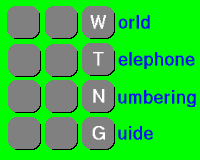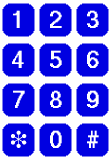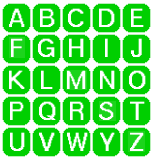


 Main Page
Main Page
 Calendar
Calendar
 Glossary
Glossary
 History
History
 Regional Services
Regional Services
 Special Services
Special Services
 What's New
What's New

|
|
|
| Updated 2 June 2011 | By Country Code | By Country Name | Other WTNG pages | Acknowledgements | ||

|

|

|
 Main Page
Main Page
 Calendar
Calendar
 Glossary
Glossary
 History
History
 Regional Services
Regional Services
 Special Services
Special Services
 What's New
What's New
|
|
||
|
|
United Kingdom | +44 | ||||
Area Code: 2-5 digits (see note below) Subscriber Number: 5-8 digits (see note below) Trunk Prefix: 0 International Prefix: 00
UK is making 10-digit national numbers standard; that is, numbers will have 3-digit area codes followed by 7-digit numbers, or 4-digit area codes followed by 6-digit numbers. Some exceptions may remain in the meantime.
Ofcom considered whether to introduce an overlay code for the existing Dartford-Gravesend areas, or to establish a new area code in the Ebbsfleet lands. Its decision on 29 April 2008 was to establish a new +44 1987 territory for Ebbsfleet, rejecting an overlay.
Source: Proposals to accommodate geographic number demand in the Ebbsfleet region (Ofcom, 2008)
(news courtesy Alex Martin)
The 030 (+44 30) sub-range of numbers is restricted to non-profit uses such as charities and government agencies.
034 (+44 34) and 037 (+44 37) are reserved for migration from the higher-cost 084 (+44 84) and 087 (+44 87) services respectively. For example, a customer with number 0845 1111111 can change to 0345 1111111, keeping the remaining sequence of digits intact.
033 (+44 33) is unrestricted, available to all customers.
Source: Ofcom: What are... 03 numbers?
030 Number Eligibility Guidance
(news courtesy Alex Martin)
There were no changes to the existing subscriber numbers in +44 20 7xxxxxxx and +44 20 8xxxxxxx ranges. This was not another split of the London calling area. The introduction of the new number range merely makes more use of London's 8-digit capacity without requiring additional disruptive dialling changes.
Source: Ofcom announcement 13 July 2004 (report courtesy Chris Ward)
Other sources on the added +44 20 3xxxxxxx number range:
Research Report, London Telephone Numbers, New Sub-Range for London, (020) 3 (PDF format)
Ofcom Press Release, "First London (020) 3 Number Blocks Released From 1 June 2005" (15 November 2004).
(with items courtesy Mark J Cuccia)
VoIP services may also use the non-geographic +44 56 number range.
(Tip courtesy Ken Westmoreland)
Source: OFCOM bulletin, 6 September 2004
Previously, OFTEL, the Office of Telecommunications, issued periodic numbering bulletins. There is an OFTEL legacy information archive available through OFCOM.
OFCOM will maintain information on telephone numbering through its website (http://www.ofcom.org.uk/telecoms/ioi/numbers/).
Previous OFTEL numbering information page is now located on the OFCOM site at: http://www.ofcom.org.uk/static/archive/oftel/ind_info/numbering/index.htm.
(some material courtesy Andrew Restall)
+44 56 range will probably be introduced in February.
Further from Ken Westmoreland:
"Other countries are introducing similar ranges prefixed with '5' for VoIP (Voice over Internet Protocol) numbering, such as Japan, South Korea, Switzerland. +41 58 (formerly used as an area code for Niederurnen) is now used for VPN numbering."
Local calling in the affected areas will be changed without any permissive or parallel period.
Sources: OFTEL Numbering Bulletin 41 and OFTEL Framework Document of 4 October 2000, updated March 2001.
The Big Number - consumer document.
Consideration is also being given to plans for European-wide telephone numbering (see Europe information).
According to the results of OFTEL's telephone numbering planning during 1996, the following places are to receive new area codes. Each of these new area codes will be followed by 8-digit local subscriber numbers, created by prefixing digits before existing subscriber numbers:
The following table indicates expected conversion from today's numbers to the new area code/local number schemes (subject to implementation details as formalised by OFTEL):
Place Current Numbers (1997) Future Numbers (2000) ============ ====================== ===================== Inner London +44 171 xxx xxxx +44 20 7xxx xxxx Outer London +44 181 xxx xxxx +44 20 8xxx xxxx Portsmouth +44 1705 xxx xxx +44 23 92xx xxxx Southampton +44 1703 xxx xxx +44 23 80xx xxxx Coventry +44 1203 xxx xxx +44 24 76xx xxxx Northern Ireland +44 xxx... +44 28 xxxx xxxx Ballygawley +44 16625 xxxxx +44 28 850x xxxx Belfast +44 1232 xxx xxx +44 28 90xx xxxx Cardiff +44 1222 xxx xxx +44 29 20xx xxxx
Also on this date, Guernsey (+44 1481, or 01481 domestically) also changed its 5-digit subscriber numbers to 6-digit numbers, by prepending the digit '2' (former subscriber numbers beginning with 3, 4, 5 or 6). Existing Guernsey 6-digit subscriber numbers (beginning with 2, 7 or 8) were unaffected.
Guernsey's GSM Code also changed from +44 4481 (04481 domestically) to +44 7781 (07781 domestically). The old and new codes will be in permissive mode for some time.
Sources, further information:
Office of Utility Regulation (Guernsey) (Guernsey is a British Crown dependency but separate from the UK)
Sure / Cable & Wireless (Guernsey carrier, previously Guernsey Telecom)
Guernsey Telecom notice on numbering change (from Internet Archive)
(with tips courtesy Keith Blackman)
+44 70 for use by personal number services
+44 71, +44 72 reserved for personal number services
Other +44 7 numbers will be used (or reserved) for mobile and paging
OFTEL is expected to determine the details of the +44 9 numbering format by July 1997.
+44 80 freephone
+44 84 local rate
+44 87 national rate
OFTEL has not set a date for which conversion to this range must be completed. Rules on migration to the standard +44 8 numbering are expected to be established by July 1997.
Additional information on the Reading code change is available in OFTEL Numbering Bulletin 34.
The following standard numbering ranges will be:
+44 1 ... geographic (conventional service) area codes
+44 2 ... geographic (conventional service) area codes
+44 3 ... reserved for future geographic area code assignments
+44 4 ... (spare range for future services)
+44 5 ... corporate numbering
+44 6 ... (spare range for future services)
+44 7 ... wireless (paging/mobile) and personal numbers
+44 8 ... specially-tariffed services
+44 9 ... premium-rate services, provision for multi-media
"Non-geographic" services such as toll-free numbers, premium charge numbers, mobile codes, etc. did not have their codes changed during this conversion, although the UK numbering plan is intended to be structured according to types of services. Some of these codes may change in the future.
The new area codes became operational from August 1994, and became mandatory to use as of 16 April 1995.
A UK Telecom FAQ item deals with reasons for/against this telephone numbering change.
 Return to Top
Return to Top